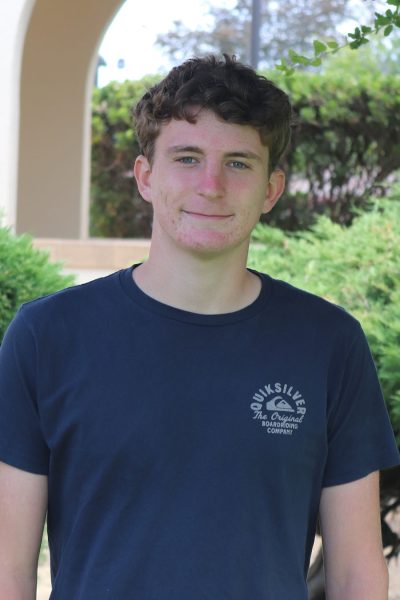Racing off his line, goalkeeper and Paly senior Jacob Kinsky glides across the turf, deflecting the shot with precision. As his teammates swarm in celebration, Kinsky glances down to see a fresh turf burn on his leg— but he shrugs it off. The save was worth the sting.
Synthetic turf has become extremely popular in the United States and is used at most high schools in the Bay Area, including Palo Alto High School. The artificial alternative to grass offers several benefits, such as increased durability and significantly less maintenance. Kinsky has grown up playing soccer for Palo Alto Soccer Club, which uses both grass and turf, but has become accustomed to turf at the high school level.
 “Turf is the standard for high school soccer, and I am used to playing on turf more than grass,” Kinsky said. “Especially as a keeper, I like turf because it’s a lot cleaner, and the fields are a lot more consistent and flat.”
“Turf is the standard for high school soccer, and I am used to playing on turf more than grass,” Kinsky said. “Especially as a keeper, I like turf because it’s a lot cleaner, and the fields are a lot more consistent and flat.”
While turf is a mainstay for sports in the United States, it’s not always the case in other parts of the world. Paly junior Reyes Aronson has played abroad in both Switzerland and Denmark while representing the Under-16 Swiss national team at training camps last November, where conditions varied.
“This was my first time going out of the country, let alone playing,” Aronson said. “It was such a cool experience, seeing their culture and the atmosphere. The Swiss playing style is very different compared to the style I grew up with. They are very technical and everything is so clean.”
In Europe, natural grass remains the preferred playing space for both professional and youth-level soccer teams. Aronson noted that these fields were significantly better than what she was used to in California. This is largely due to climate differences and field maintenance standards. Many European countries, particularly in northern and central Europe, have cooler, wetter climates that naturally support lush, green fields, reducing the need for artificial irrigation.
“Playing in the Bay Area on grass is actually worse than when I played in Europe,” Aronson said. “The grass in Europe is much greener and moist. It’s just better quality grass than California, where the grass is either very dry and mainly dirt or just too long.”
For players like Aronson, the difference is noticeable. High-quality grass fields offer better ball control, smoother movements and fewer injury risks compared to artificial turf, which can be harder on the joints.
Turf is generally more consistent, especially in varying weather conditions, whereas grass is far more volatile and often subject to drastic changes. While snow isn’t an issue in the Bay Area, rain during the winter months can negatively disrupt play with factors like mud and holes.
Paly sophomore and lacrosse player Richard Zhang tends to prefer turf, having played on it for both school and club teams.
“They both have positives and negatives,” Zhang said. “Playing on turf, you can get a little bit of abrasions or turf burn if you fall, which won’t happen on grass, but the bounce on turf is also more consistent and turf won’t get muddy like grass does if it’s raining.”
Temperature is also a major factor for turf, especially in the summer months. According to research from Penn State University, artificial turf can measure 10 to 30 degrees hotter. On particularly warm days, athletes can feel the heat, with temperatures measuring upwards of 100 degrees. At its worst, the elevated temperatures can be dangerous to athletes, with many becoming susceptible to it. The heat not only makes sports like soccer and lacrosse generally more exhausting, but it also changes the composition of the turf.

“During the summer, when it’s hotter, the melted rubber in the turf will stick to your cleats,” Zhang said. “This can be really annoying, as you have to spend a lot of time picking it out of your cleats each day.”
The debate over turf and grass is also receiving attention in the local government, as Santa Clara County considered banning synthetic turf in January. The Santa Clara County Board of Supervisors ultimately rejected the ban by a three-to-two vote, but that doesn’t mean the subject won’t be brought back up in the future. Within Palo Alto, there is an attempt to phase out turf usage with the replacement projects of prominent fields like Mayfield Sports Complex and El Camino under discussion.
This issue is also becoming relevant on the international level. With the 2026 FIFA World Cup set to be hosted primarily in the United States, strong criticism has arisen due to the playing surface. Most of the NFL fields that will be used for the tournaments are artificial turf, which creates difficult for soccer players, as it increases the chance of injuries and makes the game more difficult to play.
One of the key arguments against turf is its impact on the environment. According to the NIH, most artificial turf fields use crumb rubber infill (often made from recycled tires) or other synthetic materials that break down over time. These small plastic particles can wash away into storm drains, soil and waterways, contributing to microplastic pollution, which harms aquatic life and ecosystems.
Zhang acknowledges the environmental impacts, but believes that the costs of transitioning are not worth the benefits.
“[Turf] is not as friendly for the environment, but it is more practical for a lot of schools just to do turf because it costs more to maintain grass,” Zhang said. “I think transitioning to grass might cost too much long-term; that money could be spent better elsewhere.”
Kinsky shares these views, adding that many athletes have also developed their game on turf, with its crisp consistency being essential to the game.
“I think most sports can be played on a turf field, and should be played on turf,” Kinsky said. “Grass is expensive and hard to maintain, it is inconsistent and can change drastically depending on the weather. Turf is super easy, super clean and doesn’t require maintenance.”
However, the debate over turf or grass does not need to be a binary one. While both of Paly’s fields are turf, the idea of converting one to grass if necessary is not out of the question.
“For me both grass and turf are good options for different reasons,” Kinsky said. “I look at it like this: a 10 out of 10 grass field is the best surface in the world. But those are extremely rare, and for the most part, I prefer turf.”
As the debate over turf and grass will undoubtedly continue on both the local and national stage, the future of playing surfaces will likely involve a balance of cost, durability and playing quality. With ongoing discussions, advancements in turf technology and grass maintenance could be on the horizon. Whether fields stay synthetic or go back to their roots, the goal will be to keep sports on solid ground— without too many slip-ups.





